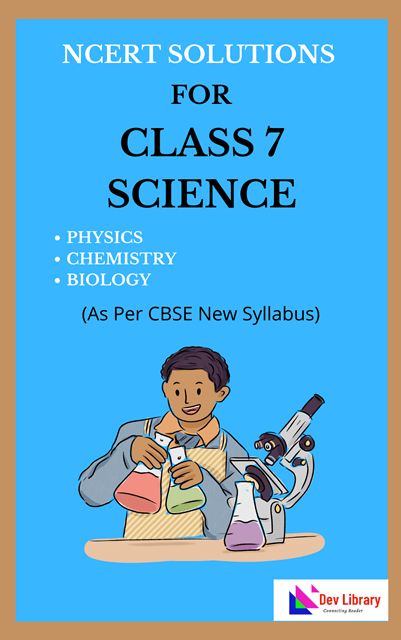NCERT Class 7 Science Chapter 17 Forests: Our Life Line Solutions to each chapter is provided in the list so that you can easily browse through different chapters NCERT Class 7 Science Chapter 17 Forests: Our Life Line and select need one. NCERT Class 7 Science Chapter 17 Forests: Our Life Line Question Answers Download PDF. NCERT Class 7 Science Solutions.
NCERT Class 7 Science Chapter 17 Forests: Our Life Line
Also, you can read the NCERT book online in these sections Solutions by Expert Teachers as per Central Board of Secondary Education (CBSE) Book guidelines. CBSE Class 7 Science Solutions are part of All Subject Solutions. Here we have given NCERT Class 7 Science Chapter 17 Forests: Our Life Line and Textbook for All Chapters, You can practice these here.
Forests: Our Life Line
Chapter: 17
NCERT TEXT BOOK EXERCISES
Q. 1. Explain how animals dwelling in the forest help it grow and regenerate.
Ans: Animals help in growing and regenera- ting forests in many ways. Animals work as the cleaning agents in the forest. Micro-organisms work on dead bodies of plants and animals and degenerate them. Animals also help in pollination which helps in growing a number of plants. Herbivores help the carnivores to grow as they serve as food for them. Thus flora and fauna grows in the forest.
Q. 2. Explain how forests prevent floods.
Ans: Forests can absorb a lot of water. The roots of the trees absorb the water and prevent it from flowing away. This helps in preventing floods.
Q.3. What are decomposers? Name any two of them. What do they do in the forest?
Ans: Decomposers are the organisms which feed on the dead bodies of the plants and animals. They clean the forests of the decaying dead bodies and replenish the nutrients back to the forest soil e.g. beetles and grubs.
Q. 4. Explain the role of forest in maintaining the balance between oxygen and carbon dioxide in the atmosphere.
Ans: Plants release oxygen in the atmosphere during the process called photosynthesis. This oxygen is inhaled by the animals living in the forest for their respirations. During respiration, they release carbon dioxide, which is absorbed by plants. In this way the O₂-CO₂ cycle goes on in the forest.
Q.5. Explain why there is no waste in a forest.
Ans: There is no waste in the forest because decomposers convert all the dead bodies of the plants and animals into the humus. Humus gets added to the soil and no waste is remained.
Q. 6. List five products we get from forests.
Ans: Products we get from forests:
(i) We get wood from forests which is used for many purposes like making furniture, paper etc.
(ii) We get medicines from forest.
(iii) We get fodder for our animals from forest.
(iv) We get gum, wax etc.
Q. 7. Fill in the blanks:
(a) The insects, butterflies, honeybees and
birds help flowering plants in _________.
Ans: Pollination.
(b) A forest is a purifier of ________ and _________ .
Ans: Water and air.
(c) Herbs form the ________ layer in the forest.
Ans: Lowest.
(d) The decaying leaves and animals droppings in a forest enrich the ________.
Ans: Soil as humus.
Q. 8. Why should we worry about the conditions and issues related to forests far from us?
Ans: We should be worried about deforestation because it would lead to floods, increase in earth’s temperature, decreasing animal habitats and soil erosion.
Q. 9. Explain why there is a need of variety of animals and plants in a forest.
Ans: All plants and animals sustain the forest life. CO₂-O₂ cycle goes on due to animals and plants. Animals convert the dead and decaying matters into humus and increase the fertility of soil. All food chains and food webs need variety of plants and animals.
Q. 10. In Fig 17.10, the artist has forgotten to put the labels and directions on the arrows. Mark the directions on the arrows and label the diagram using the following labels:
Clouds, rain, atmosphere, carbon dioxide, oxygen, plants, animals, soil, roots, water table.

Fig. 17. 10.
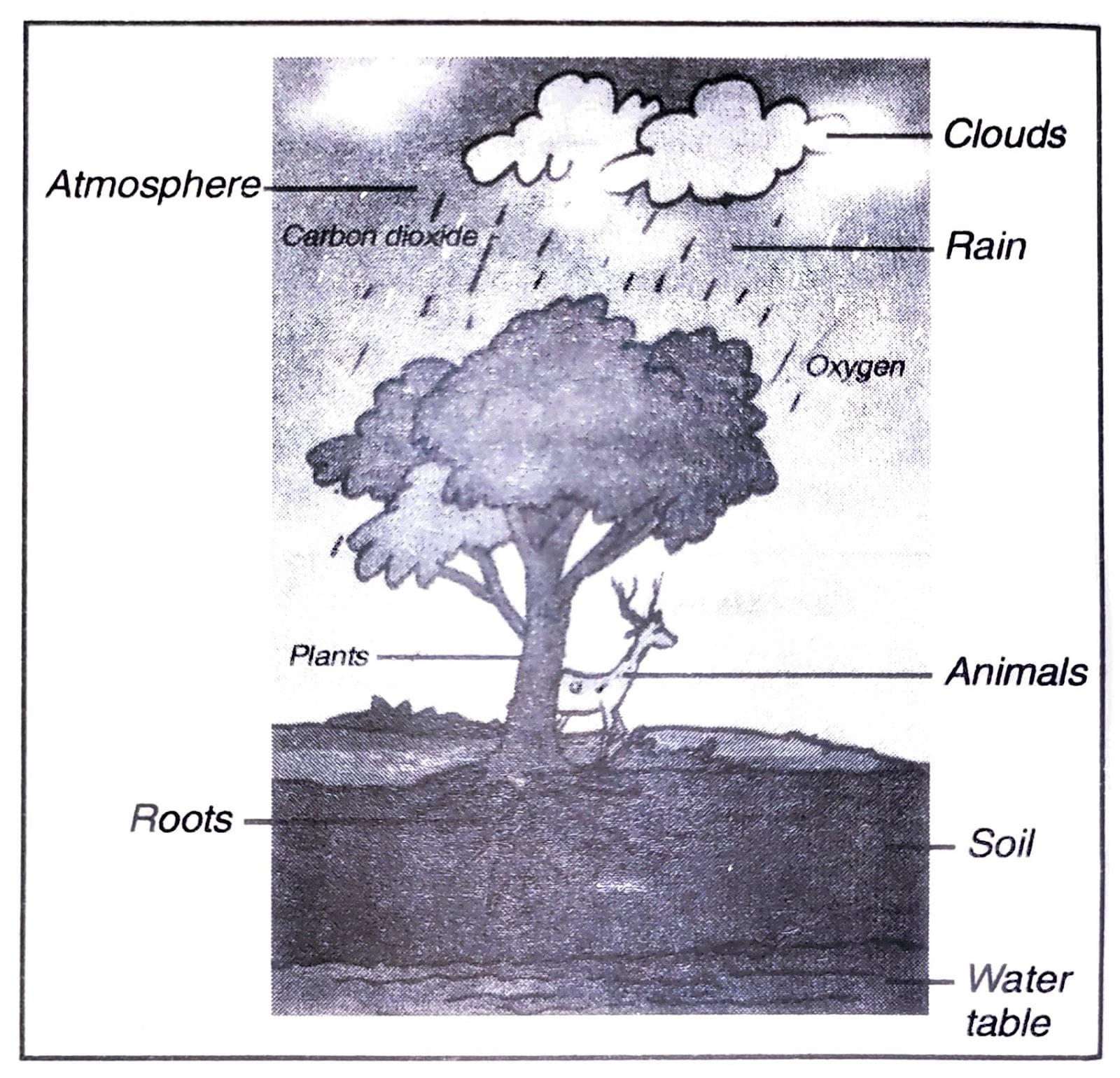
Fig. 17. 11.
Q. 11. Which of the following is not a forest product?
(i) Gum
(ii) Plywood
(iii) Sealing wax
(iv) Kerosene
Ans: (iv) Kerosene.
Q. 12. Which of the following statements is not correct?
(i) Forests protect the soil from erosion.
(ii) Plants and animals in a forest are not dependent on one another.
(iii) Forests influence the climate and water cycle.
(iv) Soil helps forest to grow and regenerate.
Ans: (ii) Plants and animals in a forest are not dependent on one another.
Q. 13. Microorganisms act upon the dead plants to produce:
(i) sand
(ii) mushrooms
(iii) humus
(iv) wood.
Ans: (iii) Humus.
ADDITIONAL IMPORTANT QUESTIONS
Very Short Type Questions Answer
Q. 1. What is the general name of the micro-organisms such as bacteria and fungi which break down plant and animal matter?
Ans: Decomposers.
Q. 2. What name is given to the branchy part of a tree above the stem?
Ans: Crown.
Q. 3. Name the top most layer of a forest.
Ans: Canopy.
Q. 4. Name the dark coloured substance formed by the action of decomposers on dead plant leaves.
Ans: Humus.
Q.5. What name is given to the branches and leaves of tall trees which look like a roof over the other plants in a forest?
Ans: Canopy.
Q. 6. There is a variation in the types of trees and other plants in different forest. Why is it so?
Ans: It is due to different climatic conditions.
Q. 7. What do you mean by food chain?
Ans: The sequence of living organisms in which one organism eats another is called a food chain.
Q. 8. Draw a food chain which operates in a forest ecosystem.
Ans: Grass → Deer → Tiger.
Q. 9. How can we recognise the presence of an animal in the forest?
Ans: By their droppings and foot-prints.
Q. 10. How do plants help in water cycle?
Ans: Trees take in water from their roots and release water vapor into the air which helps in the formation of clouds and rainfall.
Q. 11. How do animals help forest to grow?
Ans: The animals disperse the seeds of certain plants and help the forest to grow and regenerate.
Q. 12. Name two industries which are based on forest produce.
Ans: Timber, paper.
Q. 13. When are forests renewable resource?
Ans: Forests are renewable resources only if man takes care to replant the trees, he cuts down.
Q. 14. Why forests are called as green lungs?
Ans: Forests are called green lungs because they take carbon dioxide from the atmosphere and release oxygen.
Q. 15. Define forest.
Ans: Forest is a system comprising various plants, animals and microorganisms.
Short Questions Answer
Q. 1. How decomposers help in maintaining the supply of nutrients to the growing plants in a forest?
Ans: The decomposers break down dead leaves, branches and tree trunks, dead animals, and animal wastes to form humus which contains the nutrients. Humus mixes up with the soil in the forest and the nutrients present in it are used for the growth of plants. Thus decomposers help in maintaining the supply of nutrients to the trees and other plants in the forest.
Q. 2. State two differences between a consumer and a producer.
Ans:
| Consumer | Producer |
| 1. Consumers are the organisms which obtain their food by eating other organisms or their products. | 1. Producers are the organisms which produce their own food by the process of photosynthesis. |
| 2. All the animals are consumers. | 2. All the green plants are producers. |
Q. 3. Name one each of the following:
(a) producer.
Ans: Green plants.
(b) consumer.
Ans: Animals, including humans.
(c) saprotroph.
Ans: Mushroom.
(d) decomposer.
Ans: Micro-organisms, Ants.
Q. 4. Consider the following organisms:
Birds, Mushrooms, Crow, Grass, Tiger, Vulture, Frog, Toadstool, Ape, Insects, Deer.
Which of these organisms:
(a) can eat the dead animals?
Ans: Crow, Vulture.
(b) can decompose dead animals?
Ans: Mushroom, Toadstool.
(c) can pollinate the flowers?
Ans: Birds, Insects.
(d) can form a three step food chain which occurs in the forest?
Ans: Grass → Deer → Tiger.
Q. 5. X and Y are the two types of organisms which are found in forests. Both types of organisms are considered to be the cleansing agents of the forest environment in their own way. The organisms like X eat up the dead animals in the forest whereas the organisms like Y break down the dead animals into simple substance which can be re-used for the growth of plants.
(a) What is the general name of organisms like X?
Ans: Scavengers.
(b) Name one organism like X.
Ans: Vulture.
(c) What is the general name of the organisms like Y?
Ans: Decomposers.
(d) Name one organism like Y.
Ans: Fungi (like mushroom).
Q. 6. What will happen if we cut the forest?
Ans: Cutting forest can have great adverse effect on our environment. It can cause floods, it can create imbalance in CO₂,- O₂, cycle and can cause droughts, as less forest means less rains. It can make many plants and animals homeless.
Q. 7. “Forests are our benefactors”. Give two reasons for the support of this statement.
Ans: (i) Forests help in bringing rainfall, and in soil conservation (by preventing the erosion of highly fertile top soil).
(ii) Forests provide wood for the manufacture of paper and for making doors, windows and household furniture.
Q. 8. Write the two causes of deforestation.
Ans: Deforestation has taken place due to the following reasons:
(i) Due to the increasing demand of wood and timber.
(ii) Due to the increasing demand of land for constructing factories, houses, roads and dams.
Q. 9. What are the consequences of deforestation?
Ans: Deforestation would lead to:
(i) Lesser rainfall.
(ii) Imbalance between the oxygen-carbon dioxide cycle in the atmosphere.
(iii) Increased air pollution and soil erosion.
(iv) Danger to wildlife.
Q. 10. Who would have planted forest trees?
Ans: The trees produce enough seeds in nature. The forest floor provides favorable conditions for them to germinate and develop into seedling and saplings. Some grow up into trees.
Short Questions Answer
Q. 1. Explain the cycle of nutrients in the forests.
Ans: The humus indicates that the nutrients of the dead plants and animals are released in the soil. From soil these nutrients are again absorbed by roots of the living plants. The dead animals become the food for vultures, crows, jackals and insects. In this way, the nutrients are cycled.
Q. 2. Suggest any three approaches towards the conservation of forests.
Ans: The following measures are suggested for the conservation of forests:
(i) Plantation of indigenous or exotic species to develop forests in all the available land.
(ii) The forest reserves must be protected from fuel-starved villages, fodder, starved cattles and commercial exploitation.
(iii) Indiscriminate felling of trees for the purpose of timber must be reduced.
Q. 3. Why must we conserve our forests? List any two causes for deforestation taking place.
Ans: Forests are renewable natural resources which are essential for ecological balance of ecosystems. They maintain biological diversity, preserve foods and safe guards future of tribals, besides providing valuable products for human welfare and raw materials for industries.
Two causes for deforestation are:
(i) Indiscriminate felling of trees for the purpose of timber, fuel and industrial demand of wood.
(ii) Overgrazing by a large livestock population.
Q. 4. How do plants help in maintaining the oxygen-carbon dioxide balance?
Ans: In many processes such as burning of fuels and respiration, oxygen is used up and carbon dioxide is produced. The carbon dioxide so produced goes into the atmosphere. Carbon dioxide is also released into the atmosphere during many natural phenomena, such as volcanic eruptions and decay of dead animals.
Plants during photosynthesis use atmospheric carbon dioxide and release oxygen into the atmosphere. The exchange of carbon dioxide and oxygen maintains the oxygen-carbon dioxide balance in nature.
Q. 5. How do human beings depend on plants?
Ans: Human beings depend on plants for the following reasons:
(i) Human beings get their food, natural fibers like cotton, jute from plants.
(ii) Many plants and trees provide different types of medicinal compounds and spices.
(iii) Plants and trees also provide us wood, timber, rubber, gums and resin etc.
Long Type Questions Answer
Q. 1. Why are forests very important to us?
Ans: Forests are indispensable for us. They play an important role in our lives and in our environment.
Importance of the forests:
(i) Forests give us a number of products which are very useful for us. They provide us wood. Wood is used to make furniture, house, toys, sports and fuel. Forests give us many medicinal plants.
They give us gum, wax, catechu fruits, fodder and many more things:
(ii) Forests help in causing rains.
(iii) Forests maintain the temperature of the earth.
(iv) Forests maintain the O₂, CO₂, cycle going on in the environment.
(v) Forests maintain the water cycle going on in the environment.
Q. 2. Explain canopy, crown, under storey and forest floor layers of the forest.
Ans: (i) Canopy: The uppermost layer in a forest where the intertwined branches of trees form a dense roof over the ground. The tree tops block most of the sun’s rays keeping the lower layers cool and dark.
(ii) Crown: The layer where the tree trunk starts branching.
(iii) Understorey: The layer beneath the crown where small trees and large shrubs grow.
(iv) Forest floor: It is covered with dead and rotting leaves, twigs, branches and occasionally bodies of dead animals. Ferns, mushroom and grasses are found in this layer. Such plants grow in shade.
Different type of animals live in the different layers of the forest. Monkeys, birds, reptiles and amphibians like tree frogs are found in different layers of forest. Squirrels, spiders, ants and other small animals can be found on the forest floor as well as on the tree trunks. Large mammals such as elephant, tiger and deer roam freely on the forest floor. Forests are thus home to many plants and animals.
Q.3. What are decomposers? Name any two decomposers. What do decomposers do in a forest?
Ans: Decomposers: The micro-organisms which break down the dead parts of plants and dead bodies of animals into simple substances such as mineral salts (or nutrients), carbon dioxide and water, which can be reused by the plants, are called decomposers.
The micro-organisms such as bacteria and fungi are decomposers.
Decomposers (fungi and bacteria) help in recycling of nutrients. They feed on the dead and decaying bodies of plants and animals. They return the nutrients back to the soil and thus, these nutrients in the soil can be used again by the plants for their growth.
HOTS QUESTIONS
Q. 1. The organisms A and B occur on the forest floor. They convert the dead parts of forest plants and dead bodies of forest animals into simple substances such as C, D and E which can be reused by organisms F for their growth and development.
(a) What could be organisms:
(i) A and
(ii) B?
Ans: (i) Bacteria.
(ii) Fungi.
(b) What is the general name of organisms like A and B?
Ans: Decomposers.
(c) What are:
(i) C
(ii) D and
(iii) E?
Ans: (i) Nutrients.
(ii) Carbon dioxide.
(iii) Water.
(d) What could organism F be?
Ans: Plants.
Q. 2. What are the three ways by which carbon dioxide is returned back into the atmosphere?
Ans: (i) By the decomposition of dead organic matter.
(ii) As the product of respiration by both plants and animals.
(iii) As the gaseous waste formed by the combustion of fuels like coal, wood, petrol and gaseous fuels.
Q. 3. What will happen, if decomposers are removed completely from the earth? Give reason.
Ans: If decomposers are removed completely from the earth, then dead bodies of plants and animals or other dead organic matter will remain undecomposed. After some time, the dead bodies of organisms will acquire the whole space on the earth. This, existence of life will not be possible on the earth.
Q. 4. What will happen, if all plants extinct from the earth?
Ans: We are not able to survive on earth if all plants are extinct because plants are the only source of oxygen in the atmosphere.
Q. 5. Apart from the availability of forest produce, name some other things which are affected by the destruction of forests.
Ans: The destruction of forests also affects:
(i) quality of soil.
(ii) sources of water, and natural habitat of wild animals and birds.
SKILL BASED QUESTIONS
Q. 1. Draw a diagram of different types of crowns of different trees.
Ans:
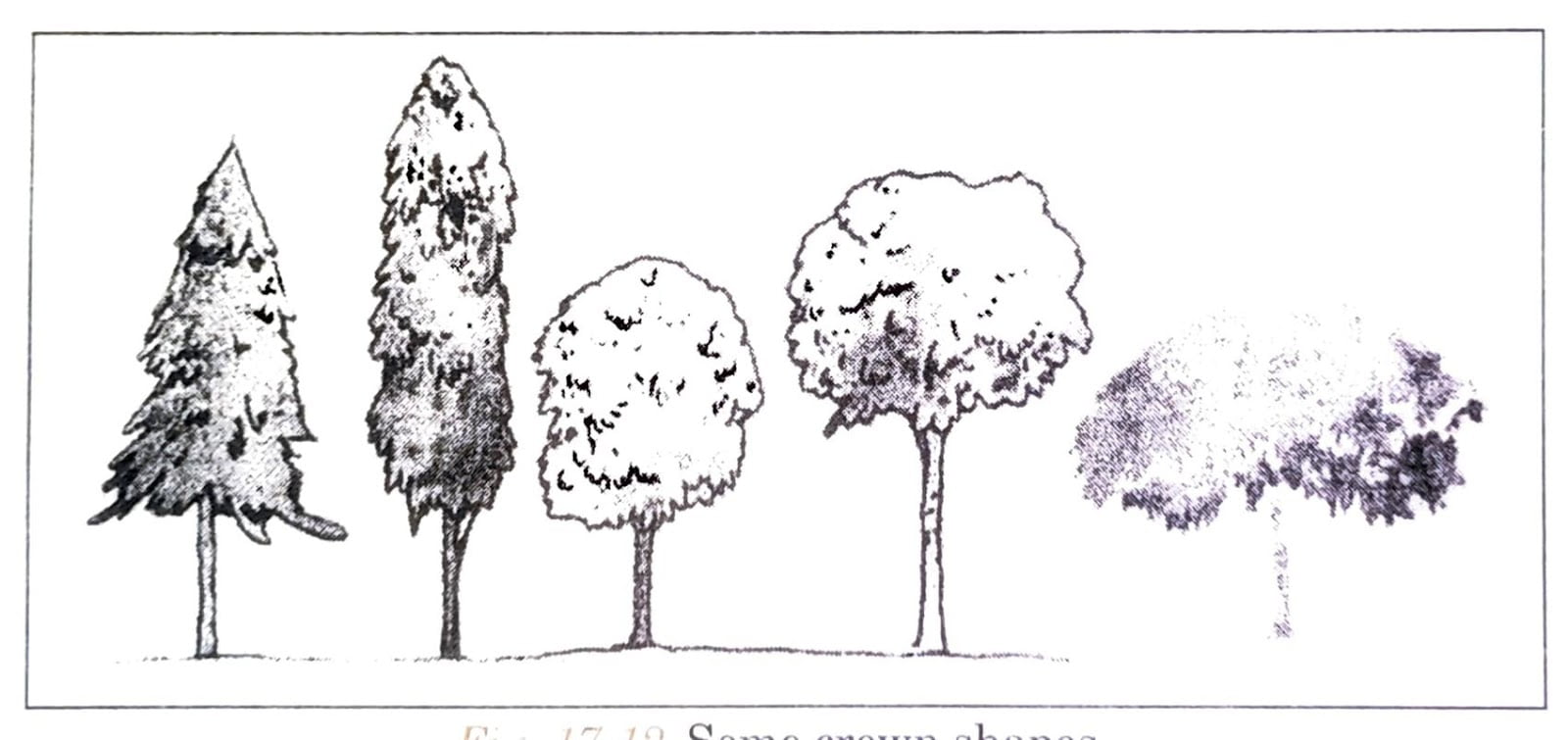
Fig. 17. 12.. Some crown shapes.
Q. 2. Draw a diagram to show canopy and understoreys. Label the following in it:
(i) Canopy.
(ii) Understoreys.
Ans:
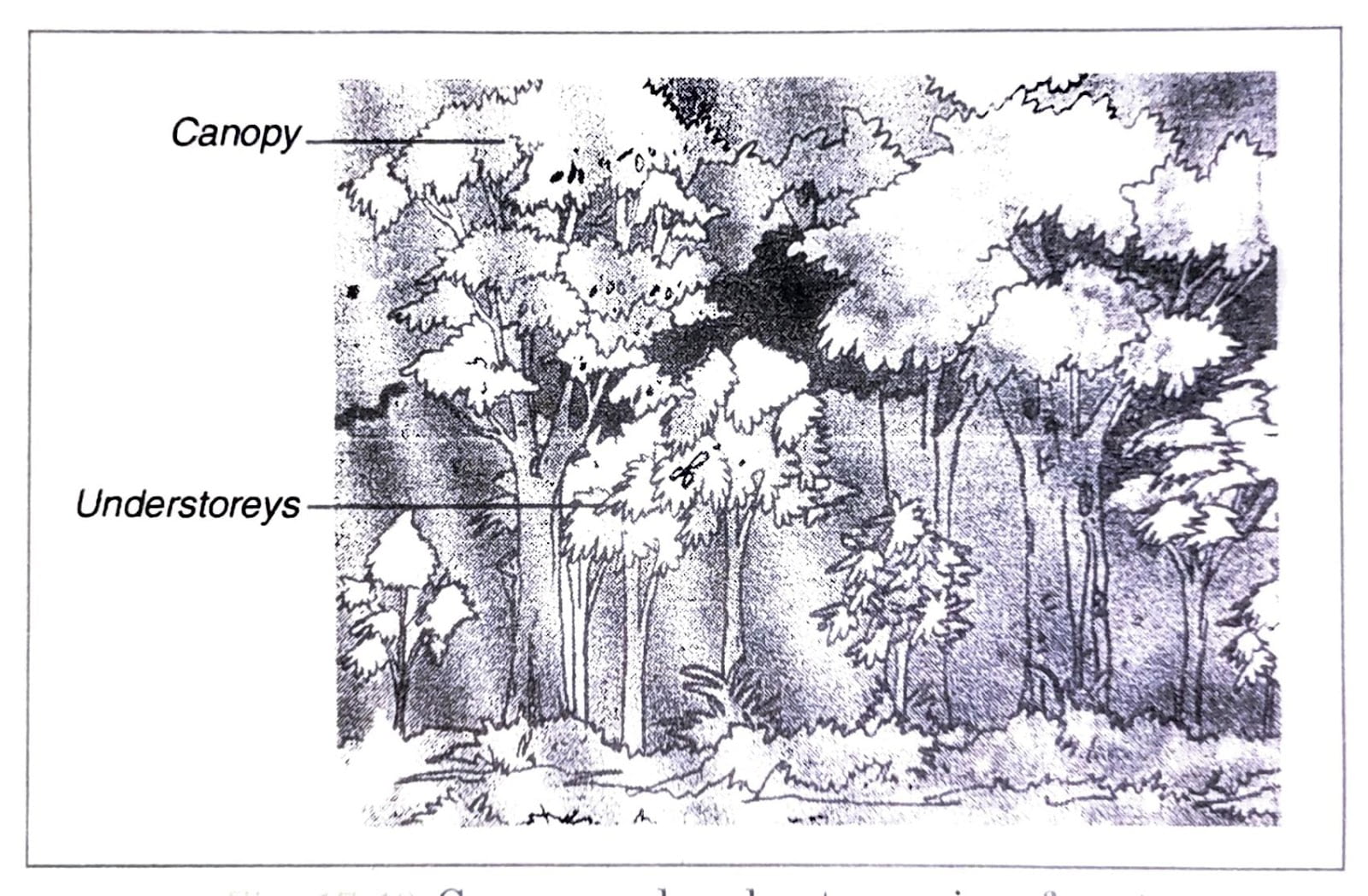
Fig. 17.13. Canopy and underscores in a forest.
Q.3. Observe the following figure and answer the following questions:
(i) Identify the figure.
(ii) Name the animals found in it.
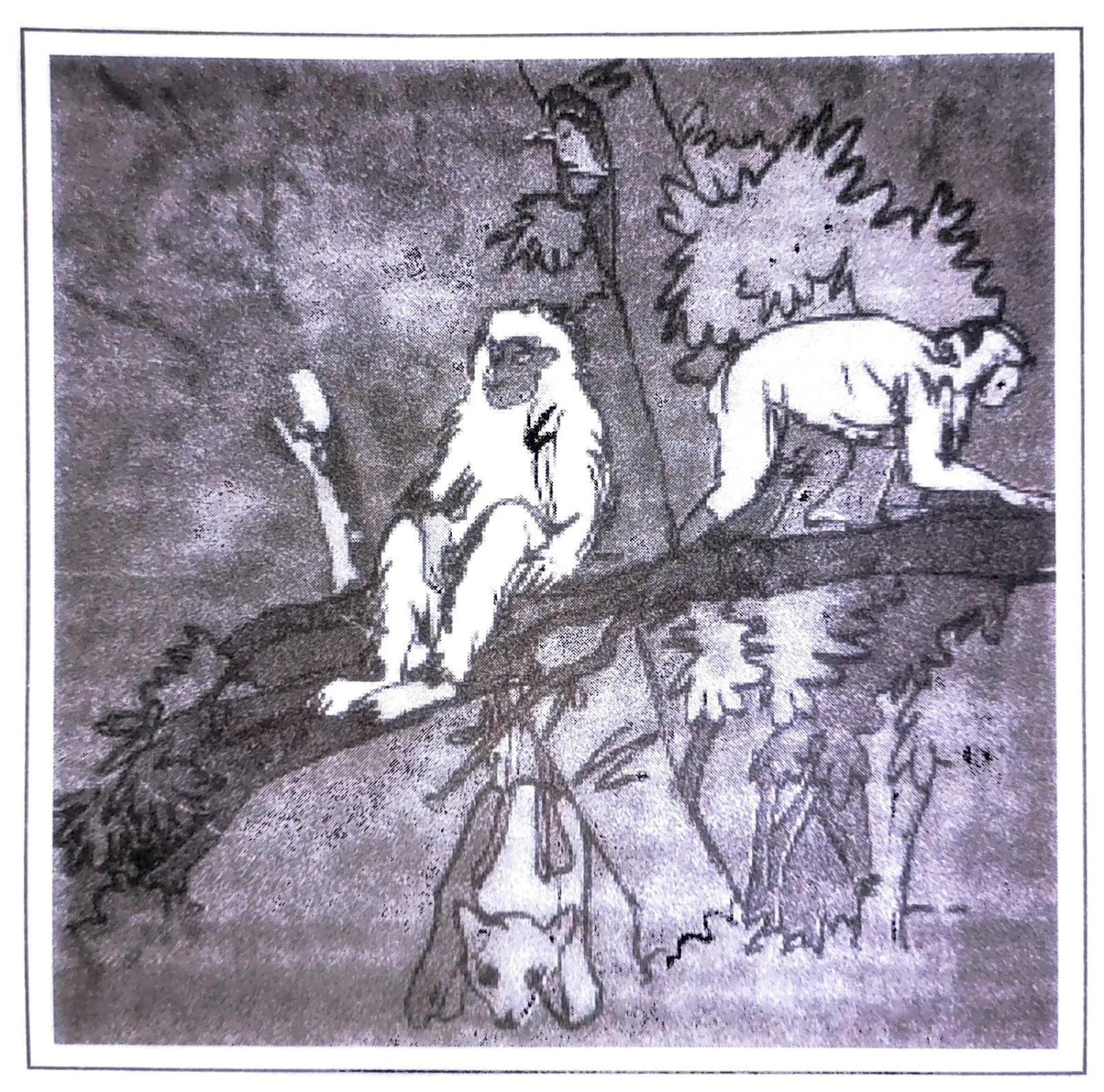
Fig. 17. 14.
Ans: (i) The figure shows forest as habitat of various types of animals.
(ii) There are some animals in the figure like apes, monkey and jackal.
FORMATIVE ASSESSMENT
Q. 1. Fill in the following blanks with suitable words:
(i) The microorganisms which convert dead plants and animals to humus are called ________.
Ans: Decomposers.
(ii) Microorganisms act upon the dead plants to produce ________.
Ans: Humus.
(iii) Forests protect the _________ from erosion.
Ans: Soil.
(iv) Different layers of vegetation provide _________ and _________ for animals.
Ans: Food, shelter.
(v) Animals provide _______ to the plants.
Ans: Carbon dioxide.
(vi) The plants having a life span of two years are called _________.
Ans: Biennials.
(vii) The top most layer of crown of tall trees is called __________.
Ans: Canopy.
(viii) Deforestation would lead to _______.
Ans: Lesser rainfall.
(ix) The organisms which eat both plants and flesh of animals are called ________.
Ans: Omnivorous.
(x) Understoreys are formed of ________ and _________.
Ans: Shrubs, grasses.
Q. 2. State whether the following statements are true or false:
(i) Mushroom is a decomposer.
Ans: True.
(ii) The natural forest trees grow on their own.
Ans: True.
(iii) Plants are saprotrophs.
Ans: False.
(iv) The roots of trees are called crown of tree.
Ans: False.
(v) Tiger is an omnivore.
Ans: False.
Q. 3. Match the statements in column ‘A’ with those in column ‘B’:
| Column ‘A’ | Column ‘B’ |
| 1. Plants | (a) Practice of planting trees |
| 2. Afforestation | (b) Deforestation |
| 3. A renewable natural resource | (c) Producers |
| 4. Removal of plants | (d) Forest |
Ans:
| Column ‘A’ | Column ‘B’ |
| 1. Plants | (c) Producers |
| 2. Afforestation | (a) Practice of planting trees |
| 3. A renewable natural resource | (d) Forest |
| 4. Removal of plants | (b) Deforestation |
Q. 4. Write one word for the following:
(i) The top most layer of crown of tall trees.
Ans: Canopy.
(ii) The organisms which derive their food from the dead and decaying animals and plants.
Ans: Saprotrophs.
(iii) The sequence of living organisms in which one eats another.
Ans: Food chain
(iv) The ground surface of the forest.
Ans: Forest floor.
(v) Dark coloured materials which cover the forest floor.
Ans: Humus.
5. Multiple Choice Questions:
(i) Which of the following is not a scavenger?
(b) Jackal
(a) Crow
(c) Lion
(d) Vulture
Ans: (c) Lion.
(ii) Which of the following will help in the conservation of forests?
(a) Recycling of jute bags
(b) Recycling of cotton bags
(c) Recycling of paper bags
(d) Recycling of plastic bags
Ans: (c) Recycling of paper bags.
(iii) Which of the following is not a correct statement?
(a) Forest trees are cut down to obtain timber.
(b) Forest trees are cut down to obtain paper.
(c) Forest trees are cut down to obtain natural rubber.
(d) Forest trees are cut down to obtain fire-wood.
Ans: (c) Forest trees are cut down to obtain natural rubber.
(iv) Which of the following is not a function of the crowns of forest trees during the day time?
(a) Absorb sun light energy
(b) Absorb oxygen from air
(c) Carry out photosynthesis
(d) Form a green cover
Ans: (b) Absorb oxygen from air.
(v) Deforestation results in:
(a) increased rainfall.
(b) increase in earth’s atmosphere
(c) increase in water level
(d) conservation of soil
Ans: (b) Increase in earth’s temperature.

Hi! my Name is Parimal Roy. I have completed my Bachelor’s degree in Philosophy (B.A.) from Silapathar General College. Currently, I am working as an HR Manager at Dev Library. It is a website that provides study materials for students from Class 3 to 12, including SCERT and NCERT notes. It also offers resources for BA, B.Com, B.Sc, and Computer Science, along with postgraduate notes. Besides study materials, the website has novels, eBooks, health and finance articles, biographies, quotes, and more.


